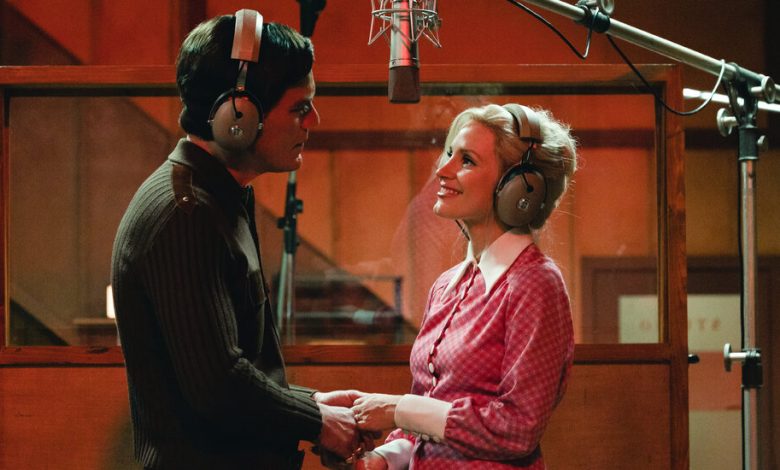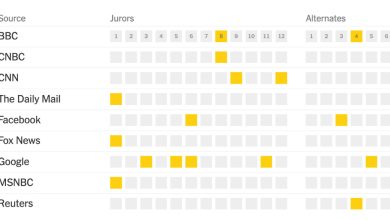Stand by Your Man? On TV, as in Life, There Are Alternatives

On Jan. 26, 1992, Hillary Clinton gave an interview to “60 Minutes.” Gennifer Flowers, a cabaret singer, had recently told a tabloid about her longtime affair with Bill Clinton, then a candidate for president. Seated on a sofa next to her husband, Hillary, prim in a blazer and headband, asserted her independence.
“I’m not sitting here, some little woman standing by my man like Tammy Wynette,” she said to the interviewer.
Wynette, by then a country music legend with a tinseled string of No. 1 songs, was, as she expressed it in an open letter, as angry as she could be. “Mrs. Clinton, you have offended every woman and man who love that song,” she wrote. “I believe you have offended every true country music fan and every person who has ‘made it on their own.’”
This was, of course, the great irony of the situation. Clinton, on that cream sofa, did stand by her man. She is still standing by. And despite what her oeuvre might suggest, Wynette, who came to Nashville as a single mother and later obtained two further divorces and one annulment, did not.
Wynette’s history — musical, marital — is revived in “George & Tammy,” a limited series, airing on Showtime, which stars Jessica Chastain as Wynette and Michael Shannon as her third husband, the country star George Jones. In its nuanced depiction of marriage and divorce, “George & Tammy” is one of several recent shows — the HBO remake of “Scenes From a Marriage,” “Fleishman Is in Trouble,” “Better Things,” “The Split” — rethinking and complicating the representation of how a marriage ends and what might come after.
“Every time we change the shape of what family looks like, it is exciting,” said Abi Morgan, speaking of her writing for “The Split,” a drama about a family of London divorce lawyers that ended a three-season run earlier this year. “Because we then open up our ideals.”
The first divorced main character to appear on scripted television was most likely Vivian Vance’s Vivian Bagley, in “The Lucy Show,” which debuted in 1962. The show’s source material, Irene Kampen’s novel “Life Without George,” centered on two divorced women, but despite that — and despite Ball’s real-life split from Desi Arnaz — her character was rendered as a widow, a move thought to invite more sympathy. Carol Brady of “The Brady Bunch” was possibly divorced, but the show, which began in 1969, the same year that California adopted no-fault divorce, never directly addressed her status. Mary Richards, the lead character of “The Mary Tyler Moore Show,” was originally pitched as divorced, but the network insisted on a broken engagement instead.
Yet as the women’s liberation movement expanded and the divorce rate rose, divorced women became more common onscreen as well as off, with creators eager to plumb both the narrative potential and the socioeconomic impact of divorce. “Nineteen-seventies television was really interested in exploring social issues,” said Annie Berke, the author of “Their Own Best Creations: Women Writers in Postwar Television.” “And divorce was a social issue.”
Why were there so few divorced male protagonists, beyond the sad sacks of “The Odd Couple”? Perhaps because divorce represented lower economic hurdles for male characters, who were presumably already in the work force and had long enjoyed lives outside the home. The potential for new experiences is minimized.
Besides, divorced men are often seen as less sympathetic. (Want sympathy? Write a widower.) If women are taught to desire marriage, the conventional wisdom goes, a wife must have had a good reason to want to end one. And if the marriage is ended for her, then she seems even more deserving of compassion. Men’s liberation carries less social heft.
In the ’70s and early ’80s, divorced and divorcing women became the heroines of numerous situation comedies such as “One Day at a Time,” “It’s a Living,” “Alice,” “Maude” and “Rhoda,” a “Mary Tyler Moore” spinoff. In these shows, which center on working-class and middle-class urban women, divorce often constitutes a financial and social injury that a heroine or sidekick weathers with heart and pluck.
In the early 2000s, a new kind of divorced woman emerged. From Charlotte of “Sex and the City” (which debuted in 1998) up through “The Starter Wife” (2007-8) and “Girlfriends’ Guide to Divorce” (2014-18), portrayals of divorce became more glamorous, more privileged. In shows that included divorce as a major plot point, splits offered women a chance to reinvent themselves, though their emancipation was often narrowly focused on luxury lifestyle choices and their pursuit of new partners. These shows divorce women not only from their spouses but also from broader political concerns. (One fulcrum show: “Designing Women,” which ended in 1993, included one divorced character, Annie Potts’s Mary Jo, who had an active investment in women’s liberation, and another, Delta Burke’s Suzanne, who did not.)
Suzanne Leonard, a professor of English at Simmons University and the author of “Wife, Inc.: The Business of Marriage in the Twenty-First Century,” sees such shows as exemplars of postfeminism or “choice feminism,” an ideology in which any choice a woman makes is seen as potentially empowering. “There was a lot of discussion during the second-wave feminist movement about the financial consequences of divorce,” she said. “And those consequences become really glossed over.”
This focus on women’s personal emancipation continued in shows like “The Marvelous Mrs. Maisel,” whose heroine becomes a comedian only after a split; “Grace and Frankie,” about frenemies whose lives are enlarged after they divorce their husbands; and “The Good Wife,” in which a politician’s wife flowers professionally (and reveals her own questionable ethics) once her marriage ends.
But in the past half decade, more series have begun to explore both signatories of a divorce decree. (Men’s liberation? Your time is now.) Sharon Horgan (“Catastrophe”) created “Divorce,” which ran on HBO from 2016 to 2019, before her own marriage ended. But even then she was determined to show both sides of the split. She was interested, she said in a recent phone interview, “in exploring a sort of flip-flop in terms of who you were rooting for or who had it worse and which character wishes they could go back.”
“Divorce” and its contemporaries — “Fleishman Is in Trouble,” “The Affair,” “Scenes From a Marriage” — suggest that divorce is not necessarily calamity or deliverance. (The comedy “The New Adventures of Old Christine,” whose heroine was presumably just as messy before her divorce as after, is an arguable forerunner.) Divorce, these shows argue, will solve some problems but not necessarily others, and it will rarely mean the definite end of a relationship, particularly if there are children involved.
“This is the secret that no one will say: Once you love a person, you don’t stop loving them,” Abe Sylvia, the creator of “George & Tammy” said. “You may have a lot of rage and a lot of anger, but that’s all coming from that kernel of connection that’s actually locked in.”
“George & Tammy” depicts divorce as necessary, a consequence of George’s alcoholism. But the legal decree doesn’t sever the connection between the two of them, who remain intermittently enmeshed, both personally and professionally. And divorce doesn’t liberate Tammy. Her subsequent marriage, to the songwriter and producer George Richey (Steve Zahn), is represented as being much worse. The problems that afflict Tammy before her divorce — a hard-charging work ethic that will eventually compromise her health, the fierceness of her attachments — dog her after.
“This empowerment people find in a third act? I think it’s a lie,” Sylvia said. “All of us are carrying along the baggage of all of our relationships at all times. George and Tammy were just honest about it.”
The divorce rate has fallen in recent years, partly because the marriage rate has as well. (According to the last census, there are 5.1 marriages per 1,000 Americans and 2.3 divorces.) At the same time, some corners of the culture seem to think traditional family structures need saving — witness, for example, the TikTok videos valorizing housewife life or the Republican rhetoric decrying no-fault divorce. And yet, divorce can offer an opportunity to rethink those structures in healthy ways, as can its representations.
“There are many ways to be a family,” Orna Guralnik, a psychoanalyst and the star of Showtime’s unscripted series “Couples Therapy,” said in a recent phone interview. “A husband and wife in a particular kind of marriage is just one option.”
Some older shows have suggested alternative family structures. In “The Golden Girls,” which began in 1985, Dorothy’s divorce from Stan precipitates her new living arrangements. “Kate & Allie,” which began the year before, presents a beautiful fantasy in which two divorced women and their kids are able to share an entire West Village brownstone. More recently, in “Better Things” and “The Split,” divorced women create rich, meaningful lives without necessarily seeking new partnerships.
In “Better Things,” which wrapped up earlier this year, Pamela Adlon plays Sam, a single mother and working actress whose biography overlaps with Adlon’s own. With three growing daughters, a vibrant group of friends and a mother who lives across the street, Sam’s life is, if anything, too full.
“There’s nothing missing,” Adlon said in a recent phone interview.
Going into the show’s third season, she remembered fielding pressquestions about whom Sam might pair with, which made Adlon more determined to have Sam stay single. “That’s when I realized how important it was to stay the course and mirror my life and the life of a lot of other women, who never do reconstitute a family,” she said.
This is, of course, one of the great gifts of television, that it can reflect back to us our own lives while also opening the possibility of new ones. The finale of “The Split,” for example, emphasizes the relationships between Nicola Walker’s Hannah and her family instead of pushing her toward a new partner.
Morgan shot two endings, one of which did suggest a romantic future for Hannah. “But actually, I felt deflated when I watched it,” she said. “I thought of all my girlfriends who had gone through divorce, and somehow I was reiterating something by saying, ‘You’re only complete by having another relationship.’”
Morgan isn’t against love, she clarified, or marriage. She has been with her husband, the writer Jacob Krichefski, for 22 years. But she believes in envisioning other forms of love, partnership and family.
“People always want happy endings,” she said. “We’re just changing the idea of what a happy ending is.”




